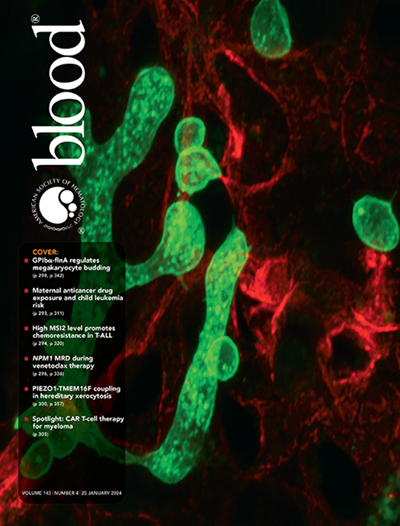A Novel Antibody-Cell Conjugation Method to Enhance Cellular Therapies for the Treatment of Hematological Malignancies
IF 21
1区 医学
Q1 HEMATOLOGY
引用次数: 0
Abstract
Introduction Cellular therapies including γδ T cells, NK-92 cells, and cytokine-induced killer (CIK) cells have shown modest anti-tumor activity against multiple hematological and solid malignancies in preclinical and phase I/II clinical trials. We investigate whether the antitumor activity of these cellular therapies can be augmented by using a novel method that rapidly affixes tumor-targeting antibodies directly to cell surface proteins. Methods Monoclonal antibodies including rituximab and daratumumab were conjugated to the cell surface proteins using a three step approach. First, we conjugate single-stranded DNAs (ssDNAs) to the therapeutic monoclonal antibodies, as previously described (ref below). Next, we conjugate complementary ssDNAs to surface proteins of cells being used for cellular therapy. Finally, the modified antibodies are attached to the modified cells via hybridization of the complementary DNA strands. Results We demonstrate that multiple anti-neoplastic monoclonal antibodies including rituximab and daratumumab can be conjugated to the surface proteins on a variety of cell including γδ T cells, NK-92 cells, CIK cells, and primary human T cells. Then we evaluated the killing activity of these conjugated cells in vitro, in vivo, and ex vivo . In vitro, Rituximab-armed γδ T cells and NK-92 cells demonstrated increased cytokine production (IFN-γ and granzyme B) and enhanced cytotoxic killing against of multiple human B-cell non-Hodgkin lymphoma (NHL) and multiple myeloma cell lines. Similar enhanced anti-tumor activity was seen with rituximab-armed or daratumumab-armed CIK cells, as well as increased CD107a expression (a marker of cytotoxicity activity) by the antibody-armed CIK cells. Rituximab-armed primary T cells also show enhanced cytotoxic killing against Raji cells, although not as pronounced as autologous rituximab-armed CIK cells. We next evaluated the therapeutic potential of antibody-armed cell therapies in vivo in a disseminated xenograft mouse model using SCID-beige mice. Rituximab-armed γδ T cells exhibited potent anti-lymphoma activity against Raji cells, which lead to improved overall survival; whereas unarmed γδ T cells alone or with rituximab co-infusion demonstrated limited anti-lymphoma activity. We also evaluated the therapeutic activity of antibody-armed cell therapies against a primary lymphoma target ex vivo. Rituximab-arm CIK cells demonstrated enhanced cytolytic activity against primary follicular lymphoma freshly collected from a patient via fine needle aspiration biopsy. Discussion We have demonstrated a novel approach to create tumor-specific cellular immunotherapies without the need for genetic engineering. The antibody to cell conjugation method is straight forward. The modified antibodies can be made and stored until needed. It takes approximately 1 hour to attaching these modified antibodies to the cell surface and is performed in standard aqueous buffers, such as phosphate-buffered saline (PBS). This method is also flexible being able to conjugate multiple different antibodies to the surface proteins of a variety of different cell types. We also see enhanced cell killing across multiple hematological targets using multiple cell populations including γδ T cells, NK-92 cells, CIK cells, and primary human T cells. Overall, our data demonstrate existing monoclonal antibodies can be used to "antibody program" cell therapies for the treatment of hematological malignancies. Ref Hsiao et al Langmuir 2009,25(12), 6985-6991 Disclosures Hsiao: Acepodia, Inc: Employment.一种新的抗体-细胞偶联方法增强细胞治疗血液系统恶性肿瘤
引言在临床前和I/II期临床试验中,包括γδT细胞、NK-92细胞和细胞因子诱导的杀伤细胞(CIK)在内的细胞疗法对多种血液学和实体恶性肿瘤显示出适度的抗肿瘤活性。我们研究了这些细胞疗法的抗肿瘤活性是否可以通过使用一种新的方法来增强,该方法可以将肿瘤靶向抗体直接粘附到细胞表面蛋白上。方法采用三步法将利妥昔单抗和达拉图单抗单克隆抗体与细胞表面蛋白偶联。首先,我们将单链DNA(ssDNA)与治疗性单克隆抗体偶联,如前所述(参考文献如下)。接下来,我们将互补的ssDNA偶联到用于细胞治疗的细胞的表面蛋白上。最后,修饰的抗体通过互补DNA链的杂交连接到修饰的细胞上。结果我们证明,包括利妥昔单抗和达拉图单抗在内的多种抗肿瘤单克隆抗体可以与多种细胞的表面蛋白结合,包括γδT细胞、NK-92细胞、CIK细胞和原代人T细胞。然后,我们评估了这些结合细胞在体外、体内和离体中的杀伤活性。在体外,利妥昔单抗武装的γδT细胞和NK-92细胞表现出细胞因子产生增加(IFN-γ和颗粒酶B),并增强了对多发性人类B细胞非霍奇金淋巴瘤(NHL)和多发性骨髓瘤细胞系的细胞毒性杀伤。使用利妥昔单抗或daratumumab武装的CIK细胞也观察到类似的抗肿瘤活性增强,并且使用抗体武装的CIK细胞CD107a表达增加(细胞毒性活性的标志物)。利妥昔单抗武装的原代T细胞也显示出对Raji细胞的细胞毒性杀伤增强,尽管不如自体利妥昔mab武装的CIK细胞明显。接下来,我们在使用SCID米色小鼠的播散性异种移植物小鼠模型中评估了抗体武装细胞疗法的体内治疗潜力。利妥昔单抗武装的γδT细胞对Raji细胞表现出强大的抗淋巴瘤活性,从而提高了总生存率;而单独或与利妥昔单抗联合输注的非武装γδT细胞显示出有限的抗淋巴瘤活性。我们还评估了抗体武装细胞疗法对原发性淋巴瘤靶点的体外治疗活性。利妥昔单抗臂CIK细胞对通过细针抽吸活检从患者新鲜采集的原发性滤泡性淋巴瘤表现出增强的细胞溶解活性。讨论我们已经证明了一种不需要基因工程就能创造肿瘤特异性细胞免疫疗法的新方法。抗体与细胞结合的方法是直接的。经过修饰的抗体可以被制造和储存,直到需要为止。将这些修饰的抗体附着到细胞表面需要大约1小时,并且在标准的水性缓冲液中进行,例如磷酸盐缓冲盐水(PBS)。这种方法也很灵活,能够将多种不同的抗体偶联到各种不同细胞类型的表面蛋白上。我们还发现,使用多种细胞群,包括γδT细胞、NK-92细胞、CIK细胞和原代人类T细胞,在多个血液学靶点上增强了细胞杀伤。总的来说,我们的数据表明,现有的单克隆抗体可以用于“抗体程序”细胞治疗血液系统恶性肿瘤。Ref Hsiao等人Langmuir 2009,25(12),6985-6991披露Hsiao:Acepodia,Inc:就业。
本文章由计算机程序翻译,如有差异,请以英文原文为准。
求助全文
约1分钟内获得全文
求助全文
来源期刊

Blood
医学-血液学
CiteScore
23.60
自引率
3.90%
发文量
955
审稿时长
1 months
期刊介绍:
Blood, the official journal of the American Society of Hematology, published online and in print, provides an international forum for the publication of original articles describing basic laboratory, translational, and clinical investigations in hematology. Primary research articles will be published under the following scientific categories: Clinical Trials and Observations; Gene Therapy; Hematopoiesis and Stem Cells; Immunobiology and Immunotherapy scope; Myeloid Neoplasia; Lymphoid Neoplasia; Phagocytes, Granulocytes and Myelopoiesis; Platelets and Thrombopoiesis; Red Cells, Iron and Erythropoiesis; Thrombosis and Hemostasis; Transfusion Medicine; Transplantation; and Vascular Biology. Papers can be listed under more than one category as appropriate.
 求助内容:
求助内容: 应助结果提醒方式:
应助结果提醒方式:


